|
 Nederlands
/ Dutch Nederlands
/ Dutch
Subpage flies:
Tachinidae
Blow-flies
(Calliphoridae) House
flies (Muscidae) Soldierflies
(Stratiomyidae) Root-Maggot
Flies (Anthomyiidae)
Small
flies Gnats
Hoverflies, Syrphidae
|
Hoverflies,
Flower
Flies
(Syrphidae) One of their characteristics is their bee, wasp or bumblebee
mimicry, whereas they are completely defenceless. Flower flies cannot
sting. They have same the
bright colours, and sometimes the dense hair covering of bumblebees.
Hovering is a speciality, but they are also fast and very manoeuvrable.
The difference with other flies is the spurious vein. This vein neither
ends nor connects with other wing veins. The
spurious vein just ends for the edge of the wings.
Cell 2 is closed. The closed cell 4 is longer or as long as one third of
the length of the wing.
The arista is on the side of the third antennal segment. Not on the top.
On the thorax are no stiff hairs like other flies.
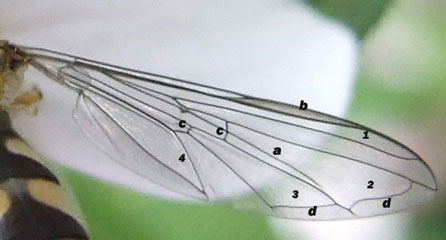 .. ..

Wing of a Meliscaeva
auricollis.
Antenna of a volucella zonaria.
Wing:
1, 2, 3, 4: closed cell
a: vena spuria or a false vein
b: stigma
c: cross vein
d: outer cross vein |
Antenna:
1: third antennal segment (you can't see the other two
on this photo)
2: arista
|
Females
have smaller eyes which are placed farther apart. The eyes of the male
meet at the top of the head. Of course there are exceptions. Than you have
to look at the underside of the abdomen, males have curbed asymetricla
genitalia. The abdomen of the female is more pointed with inconspicuous
genitalia.
Many species feed mainly on nectar and pollen. The larvae (maggots) eat a
wide range of foods.
Exceptions
No vena spuria: Eristalinus sepulchralis and Psilota anthracina.
Arista op the top: Callicera and Ceriana
Stiff hairs: Ferdinandea. Less: Volucella, Cheilosia, Brachyopa and
Chamaesyrphus.
(Information from: Zweefvliegtabel van Aat
Barendregt)
|
Other hoverflies on hoverflies
1
Wasp mimics
Episyrphus.
 Photo 11-6-2014. A pupa of a Marmalade Fly (Episyrphus balteatus). A beautiful marmalade fly came out on 18-6-2014. But the pupae of other hoverflies can of course also look like this.
Photo 11-6-2014. A pupa of a Marmalade Fly (Episyrphus balteatus). A beautiful marmalade fly came out on 18-6-2014. But the pupae of other hoverflies can of course also look like this. |
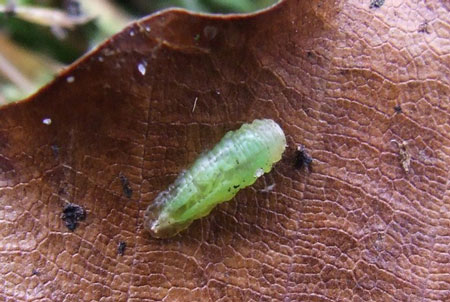 Hoverfly larva. Photo 7-3- 2009.
This is a larva of a hoverfly. That day I found
two between the leaves.
Hoverfly larva. Photo 7-3- 2009.
This is a larva of a hoverfly. That day I found
two between the leaves.
There's still much to discover concerning the larvae of hoverflies. Just
maybe it's a larva of a Marmalade Fly (Episyrphus balteatus). But that
is certainly not certain.
The larva feeds on aphids. |
Sericomyia
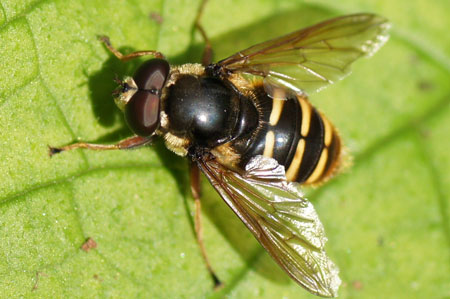 .. ..
 . .
 . .
 Yellow-barred Pond Fly (Sericomyia silentis). Genus: Sericomyia. Family hoverflies (Syrphidae).
Yellow-barred Pond Fly (Sericomyia silentis). Genus: Sericomyia. Family hoverflies (Syrphidae).
A large black fly with yellow, narrowly
wedge-shaped abdominal bars, which usually do not quite meet in the centre
of the abdomen. The end of the abdomen is yellow.
The edge of the wings is rose brown.
It looks like a large social wasp (Vespa species).
It is a species primarily of peatland areas. But also in other areas as in
my garden.
The rat-tailed
maggots live like the maggots of for
example the Eristalis species in the water.
Length: 14-18 mm. Mai-October. German: Große
Torf-Schwebfliege,
Gelbband-Torfschwebfliege.
|
Helophilus.
The larvae, rat-tailed maggots, live in muddy water.
Often in decaying plants.
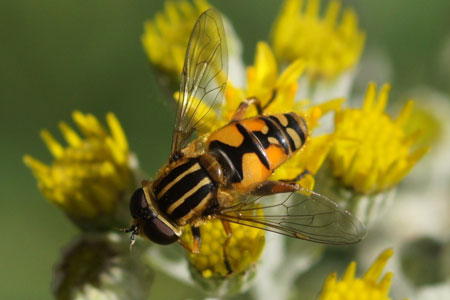 .. ..
 . .
 . .
 Sun fly, Tiger Marsh Fly
(Helophilus pendulus).
Genus: Helophilus. Family hoverflies (Syrphidae).
Sun fly, Tiger Marsh Fly
(Helophilus pendulus).
Genus: Helophilus. Family hoverflies (Syrphidae).
One
of the most
common hoverflies in my garden. It is especially to be
found near water and marshes. It
has black and yellow longitudinal stripes on the upper surface of its
thorax.
It has has a black middle stripe on the face. On the first two abdominal segments are yellow spots.
The hind leg: the thigh is 1/3 yellow on the top and the tibia 2/3 yellow
with a black top. A black tarsus of the foreleg.
Length: 11-13 mm. April-October.
There
are more Helophilus species similar to these flies. For example the
Helophilus hybridus and
Helophilus trivittatus. German:
Gemeine Sumpfschwebfliege
Frech: Hélophile suspendu.
|
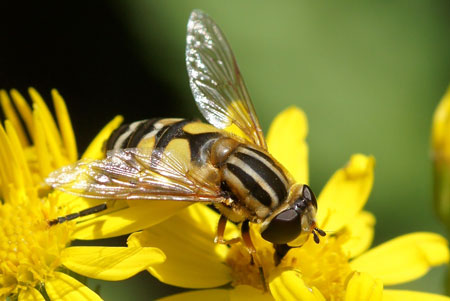 .. ..
 . .
 . .
 Sun fly, Lemon Marsh Fly
(Helophilus trivittatus).
Genus: Helophilus. Family hoverflies (Syrphidae).
Sun fly, Lemon Marsh Fly
(Helophilus trivittatus).
Genus: Helophilus. Family hoverflies (Syrphidae).
A wasp- like hoverfly. It
has black and yellow longitudinal stripes on the upper surface of its
thorax.
It is similar to the Sunfly, Helophilus
pendulus. On the first two abdominal segments are lemon yellow spots. The spots below are more white.
Helophilus trivittatus has a
yellow middle stripe on the face.
German:
Große Sumpfschwebfliege.
|
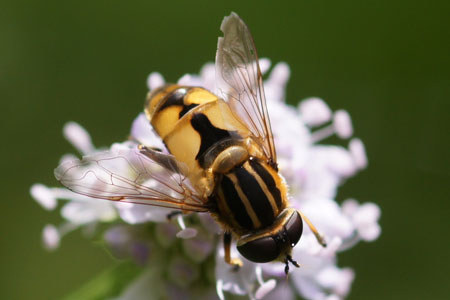 .. ..
 . .
 . .
 Sun fly, Woolly-tailed Marsh Fly (Helophilus
hybridus). Genus:
Helophilus. Family hoverflies (Syrphidae).
Sun fly, Woolly-tailed Marsh Fly (Helophilus
hybridus). Genus:
Helophilus. Family hoverflies (Syrphidae).
On the first two abdominal segments are yellow spots. Photos 18-8-2010.
German:
Helle Sumpfschwebfliege |
Parhelophilus.
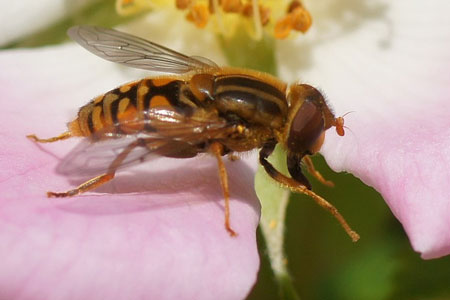 .. ..
 Parhelophilus versicolor or Parhelophilus frutetorum. Genus Parhelophilus.
Not in the garden but in the dunes about 4 km from
our house. I've seen this hoverfly once in our garden, but I didn't
succeed to take a photo.
Parhelophilus versicolor or Parhelophilus frutetorum. Genus Parhelophilus.
Not in the garden but in the dunes about 4 km from
our house. I've seen this hoverfly once in our garden, but I didn't
succeed to take a photo.
Both species look very much alike. They look
like the sun fly, but they are orange brown and hairy. The antennae are orange. The face is orange yellow.
The larvae live underwater in the mud. They overwinter as larvae and pupate above water on the marsh plants.
Parhelophilus versicolor : On
the head behind the eyes are between the yellow hairs some black hairs.
Length: 9-11 mm. May-September.
Parhelophilus frutetorum: On the head behind the eyes are only yellow hairs.
Length: 8-10 mm. May-August. The Parhelophilus frutetorum is less
common in the Netherlands. Photos 5-7-2013.
|
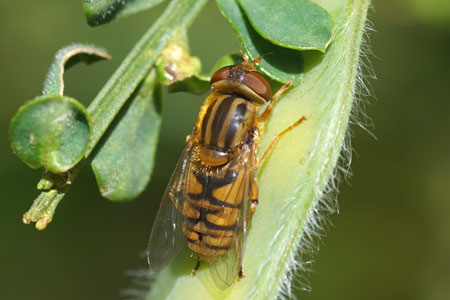 .. ..
 Marsh Stripeback (Parhelophilus versicolor). Genus Parhelophilus. Family hoverflies
(Syrphidae).
Marsh Stripeback (Parhelophilus versicolor). Genus Parhelophilus. Family hoverflies
(Syrphidae).
Finally photographed a Parhelophilus versicolor in the
garden! Photos 22-6-2024.
|
Anasimyia.
 .. ..
 . .
 Ditch Swamp Fly (Anasimyia interpuncta). Genus: Anasimyia. Family hoverflies (Syrphidae).
Ditch Swamp Fly (Anasimyia interpuncta). Genus: Anasimyia. Family hoverflies (Syrphidae).
It looks a little like the Helophilus, but the Anasimyia is not as
bright-colored and smaller.
The spots on the body are curved. The
Anasimyia has no middle stripe on the face.
Length: 8-11 mm.
April-September. The larvae overwinter. Palearctic. Photos 25-9-2012. |
Chrysotoxum.
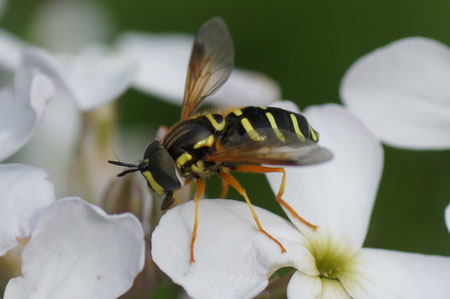 .. ..
 . .
 Hook-banded Meadow Fly (Chrysotoxum festivum).
Genus: Chrysotoxum. Family hoverflies (Syrphidae).
Hook-banded Meadow Fly (Chrysotoxum festivum).
Genus: Chrysotoxum. Family hoverflies (Syrphidae).
This hoverfly has a long antennae, so the fly can easily be mistaken with
a wasp.
Chrysotoxum festivum is very similar to Chrysotoxum vernale. The thighs of
the Chrysotoxum festivum are yellow.
The base of the thighs of the Chrysotoxum vernale is black.
Palearctic. April-September.
Length 11-15 mm.
Photos 11-6-2012. |
Ceriana.
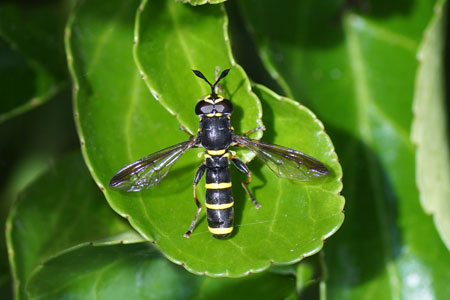 Common Wasp Fly (Ceriana conopsoides). Genus: Ceriana. Family hoverflies
(Syrphidae).
Common Wasp Fly (Ceriana conopsoides). Genus: Ceriana. Family hoverflies
(Syrphidae).
Just like Chrysotoxum with long antennae. There is another very rare species in the Netherlands, the Ceriana vespiformis. Larvae in tree wounds. Known for elm and poplar. Especially in southern part of Europe. Was rare in the Netherlands, but is now more common. First seen in the garden in 2023.
Palearctisch. April-August. Length 11-14 mm. Photo 12-7-2023. |
Temnostoma.
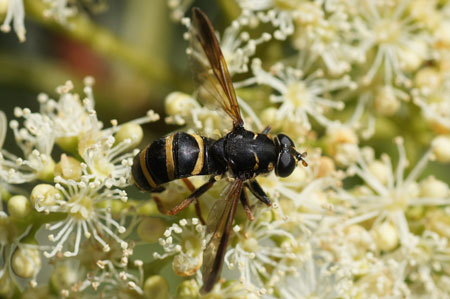 Dusky Falsehorn (Temnostoma bombylans). Genus: Temnostoma. Family hoverflies (Syrphidae).
Dusky Falsehorn (Temnostoma bombylans). Genus: Temnostoma. Family hoverflies (Syrphidae).
A black abdomen with thin yellow bands. It looks like the Chrysotoxum festivum, but has much smaller light antennae. Upper part of the legs is dark, the lower part is light brown.
The larvae are found in old stumps and trunks, which are often saturated with water.
Palearctic. April-June. Length 12-16 mm. Photo 31-5-2014. |
Xanthogramma.
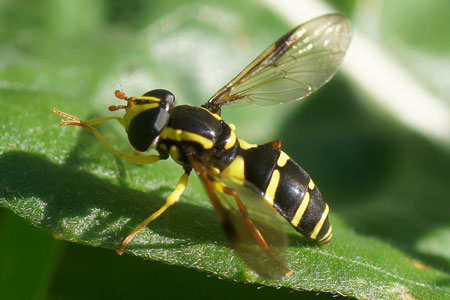 .. ..
 . .
 . .
 Superb Dayglower (Xanthogramma pedissequum).
Genus Xanthogramma. Family hoverflies (Syrphidae).
Superb Dayglower (Xanthogramma pedissequum).
Genus Xanthogramma. Family hoverflies (Syrphidae).
A black glider with lemon yellow spots and legs. The sides of the thorax has a yellow stripe. The hind legs are darker. Length 10-12 mm.
May-September.
The larva lives in the nests of some species of ants. The ants don't attack the larva. They feed on root aphids.
Palearctic.
Photos 8-9-2012, 17-6-2013, 14-6-2014, 20-6-2014. |
Syrphus.
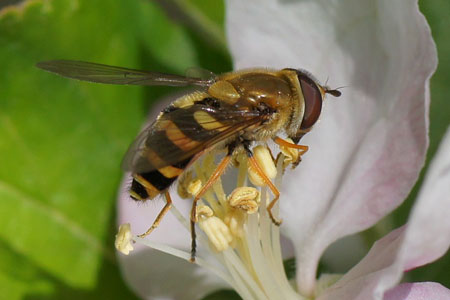 .. ..
 . .
 . .
 Common
banded hoverfly,
Common Flower Fly (Syrphus
ribesii). Genus: Syrphus.
Family hoverflies (Syrphidae).
Common
banded hoverfly,
Common Flower Fly (Syrphus
ribesii). Genus: Syrphus.
Family hoverflies (Syrphidae).
The
female S. ribesii is the only female of the syrphus species with entirely
yellow thighs. The male is not so easy to determine for
the thighs of the hind leg are partially dark, like other species.
At the top of the thigh of hind leg on the outer side are very small black hairs.
There are of course a number of species, which are similar . Especially
the Syrphus torvus and the Syrphus vitripennis.
Length: 9-13 mm.
The larvae of the three species feed on aphids.
April-November. Photos 5-5-2010, 22-5-2013. German: Große
Schwebfliege, Gemeine
Garten-Schwebfliege

 Larva Syrphus ribesii according to Gerard Penards. 20-8-2011.
Larva Syrphus ribesii according to Gerard Penards. 20-8-2011. |
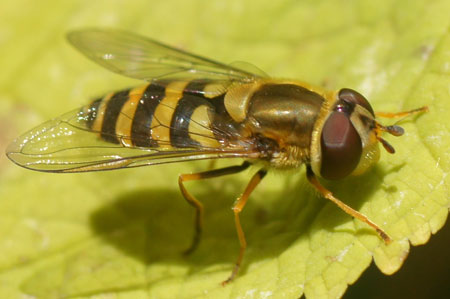 .. ..
 Black-thighed Flower Fly (Syrphus vitripennis). Female. Genus: Syrphus. Family hoverflies (Syrphidae).
Black-thighed Flower Fly (Syrphus vitripennis). Female. Genus: Syrphus. Family hoverflies (Syrphidae).
The eyes are hairless. The thighs of the hind leg are partially dark.
At the top of the thigh of hind leg on the outer side
are very small yellow hairs. Sometimes there are
also some black hairs. But to see these hairs, you need a microscope or a very good camera. I tried to photograph it. Usually it failed because they were sitting on a yellow flower.
Length: 8 tot 12 mm. March - November. Photos
3-10-2013.

 Detail hind thigh and eyes.
Detail hind thigh and eyes. |
 Male Syrphus
ribesii, Syrphus torvus or Syrphus vitripennis.
Male Syrphus
ribesii, Syrphus torvus or Syrphus vitripennis. |
The hoverflies of the genus Syrphus look like
some of the hoverflies of the genus Epistrophe on
the page hoverflies
1.
Parasyrphus.
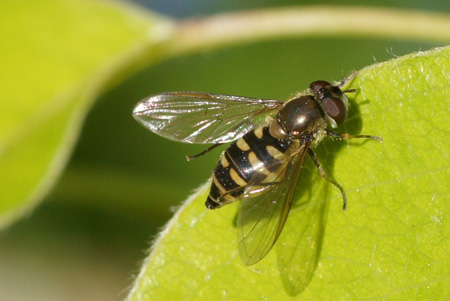 .. ..
 . .
 . .
 Common Spotted Bristleside (Parasyrphus
punctulatus). Genus: Parasyrphus. Family hoverflies (Syrphidae).
Common Spotted Bristleside (Parasyrphus
punctulatus). Genus: Parasyrphus. Family hoverflies (Syrphidae).
The semicircular spots on its abdomen, which reach the outside edge of the
abdomen. The thorax is dull.
On the face is a black stripe.
Length 6-9 mm.
April-June. Palearctic.
The larvae feed on aphids. |
Eupeodes.
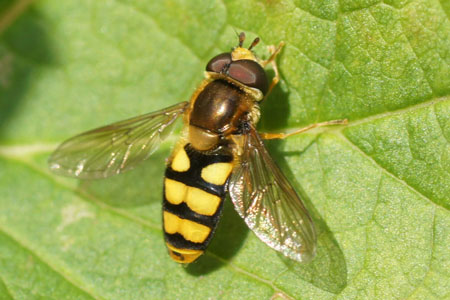 Broad-banded Aphideater (Eupeodes latifasciatus). Genus: Eupeodes. Family hoverflies (Syrphidae).
Broad-banded Aphideater (Eupeodes latifasciatus). Genus: Eupeodes. Family hoverflies (Syrphidae).
Wide bands (commas), rarely narrow. In the male, the spots are often broadly connected.
Eupeodes corollae looks also similar.
The eyes are not hairy.
Length: 8-10 mm.
April-October. Photo 18-9-2015.
German: Breitband-Feldschwebfliege.
|
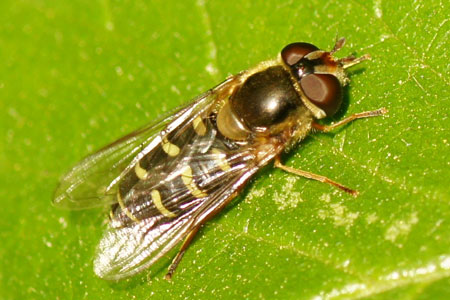 .. ..
 . .
 Bow-veined Aphideater (Lapposyrphus lapponicus
synonym Eupeodes lapponicus). Family hoverflies (Syrphidae).
Bow-veined Aphideater (Lapposyrphus lapponicus
synonym Eupeodes lapponicus). Family hoverflies (Syrphidae).
Abdomen with (often narrow) curved spots. Vein 3 in the wing with a deep bend. (difference with the other Eupeodes species). Through the vein it is also placed in Scaeva. The spots also resemble those of the Scaeva selenitica. Other people had placed it in the genus Lapposyrphus. Eyes not hairy.
The females hibernate. Therefore, they may be more numerous after a mild winter. In our country there aren't found wintering females yet. Many flies in the Netherlands are here through migration.
Length: 9-12mm. April-August.
The larvae feed on aphids. holarctic. Photos 6-05-2014, 19-6-2014. |
Scaeva.
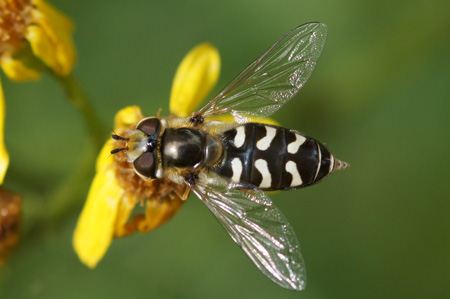 .. ..
 . .
 . .
 White-bowed Smoothwing (Scaeva pyrastri). Genus: Scaeva. Family hoverflies (Syrphidae).
White-bowed Smoothwing (Scaeva pyrastri). Genus: Scaeva. Family hoverflies (Syrphidae).
Small photos 29-7-2008:
I tried to photograph it without success. But when my wife had a bought
a hebe for in a pot, it waited in the air, until she was ready. Then it stayed for a long time on the
flowers.
It looks a bit like an Eupeodes.
Black with three pairs of white, sometimes slightly yellow tilted spots.
The Scaeva selenitica has right spots.
Length: 10 - 15 mm.
April - October.
The pale green larvae feed on aphids. Holarctic and Oriental. |
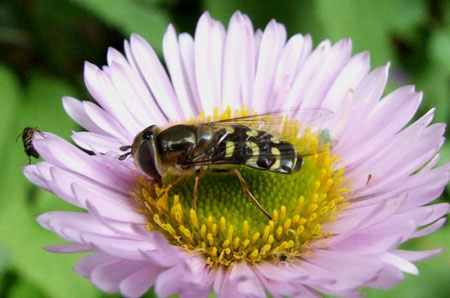 .. ..
 . .
 Yellow-bowed Smoothwing (Scaeva selenitica). Genus: Scaeva. Family hoverflies (Syrphidae).
Yellow-bowed Smoothwing (Scaeva selenitica). Genus: Scaeva. Family hoverflies (Syrphidae).
The
difference with the white Scaeva pyrastri are the yellowish spots (sometimes
whitish) and the spots are right on the abdomen.
It also looks like an Eupeodes, but a Scaeva has hairy eyes.
In side view the forehead is swollen.
Length: 10-15 mm.
February-November.
The pale green larvae feed on aphids.
Palearctic. Photos 7-6-2009, 4-6-2012. |
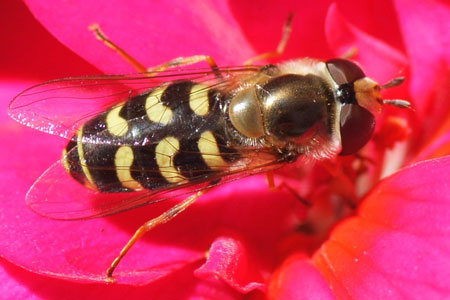 .. ..
 . .
 Southern Smoothwing (Scaeva dignota). Genus: Scaeva. Family hoverflies (Syrphidae).
Probably, not certain!!1 Very rare!!!
Southern Smoothwing (Scaeva dignota). Genus: Scaeva. Family hoverflies (Syrphidae).
Probably, not certain!!1 Very rare!!!
I thought it was a Scaeva selenitica. Menno
Reemer pointed out to me, that
probably it is a Scaeva dignota. In the Netherlands it is very rare.
Thanks Menno!
The difference with the Scaeva selenitica is, that the spots reach the outside edge of the abdomen. The spots are often slightly paler and wider. The forehead is less swollen.
It is found occasionally in the southern Netherlands (And once a larva in Amsterdam).
It's possible, that the larva of
this hoverfly has traveled with a plant form another part of Europe, but according to Menno Reemer they can
fly long distances in summer.
Length: 10-15 mm.
April-August. The larvae reed on aphids.
Palearctic. Photos 13-6-2012. |
Dasysyrphus
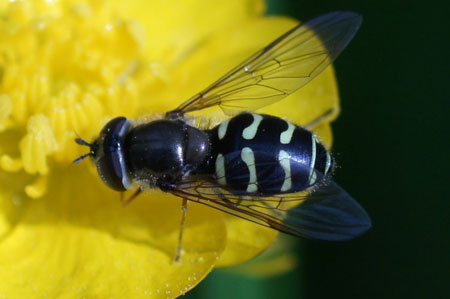 .. ..
 . .
 Black-spotted Brusheye (Dasysyrphus pinastri). Genus: Dasysyrphus. Family hoverflies (Syrphidae).
Not in the garden but in the dunes about 4 km from
our house.
Black-spotted Brusheye (Dasysyrphus pinastri). Genus: Dasysyrphus. Family hoverflies (Syrphidae).
Not in the garden but in the dunes about 4 km from
our house.
The spots with a thickened end are similar to those of a
Scaeva. The spots don't reach the outside edge of the
abdomen. On the dark brown scutellum are black
hairs.
Especially near coniferous forest.
Length: 9-11 mm.
April-July.
The larvae feed on aphids. Holarctic. |
Platycheirus.
This group hoverflies can be recognised by the forefoot. The tarsus of the
front legs of this species has widened.
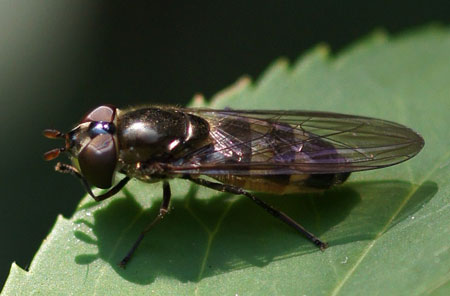 .. ..
 . .
 . .
 Grey-spotted Sedgesitter (Platycheirus albimanus). Genus: Platycheirus. Family hoverflies (Syrphidae).
Grey-spotted Sedgesitter (Platycheirus albimanus). Genus: Platycheirus. Family hoverflies (Syrphidae).
They can be found in woodland edge,
hedgerows, scrub and gardens. On the abdomen silvery (mica color) or yellowish spots.
The larvae appear to feed on aphids on low
growing plants and bushes. Length: 7- 9 mm.
March-October. |


 Platycheirus ambiguus.
Genus: Platycheirus. Family hoverflies (Syrphidae). Female. A very rare species in the Netherlands!!
Platycheirus ambiguus.
Genus: Platycheirus. Family hoverflies (Syrphidae). Female. A very rare species in the Netherlands!!
Two years later I photographed the female. Like the male
it looks like the Platycheirus albimanus. The female has broad blue shiny
spots, but they are almost invisible on the black abdomen.
Photos 28-4-2013. Thanks Menno. |
 .. ..
 Long Sedgesitter (Platycheirus europaeus).
Genus: Platycheirus. Family hoverflies (Syrphidae).
Not in the garden but in the dunes about 4 km from
our house.
Long Sedgesitter (Platycheirus europaeus).
Genus: Platycheirus. Family hoverflies (Syrphidae).
Not in the garden but in the dunes about 4 km from
our house.
On the first segment of tarsus 1 on the foreleg of the male is a black pattern in the shape of a Z. Orange spots on the abdomen. It looks a lot like Platycheirus clypeatus and Platycheirus
occultus. Especially the female is smaller and the spots are slightly smaller.
Determined by Jaap van der Linden. Thanks Jaap.
Grasslands near forests, forest edges, forest lakes. The adult
platycheirus is visiting flowering grasses, plantain and greater
stitchwort.
The larvae feed on aphids.
Length: 7-9 mm.
May-Augustus. Photos 15-7-2013.
|
Pelecocera.
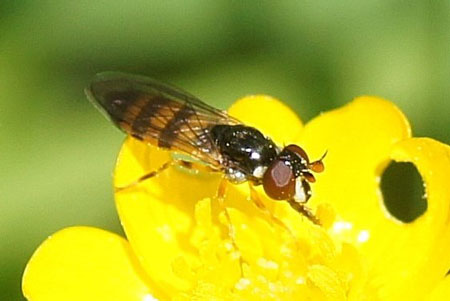 .. ..
 . .
 Common Bighorn Fly (Pelecocera tricincta). Genus: Pelecocera. Family hoverflies
(Syrphidae). Not in the garden but in the dunes about 4 km from
our house.
Common Bighorn Fly (Pelecocera tricincta). Genus: Pelecocera. Family hoverflies
(Syrphidae). Not in the garden but in the dunes about 4 km from
our house.
On a buttercup. Striking are the ax-shaped antennas with a thick
arista.
It is found on sandy soils, heath, nutrient-poor grassland, woodland edges, like here in the dunes.
There is not much known about the larvae.
Length: 4-5 mm.
June-September. Photos 18-6-2013.
|
Chamaesyrphus.
Sometimes Chamaesyrphus is described as a synonym of Pelecocera. There are indeed many similarities.
 .. ..
 Dune Bighorn Fly (Pelecocera lusitanica syn.
Chamaesyrphus lusitanicus). Genus:
Chamaesyrphus. Family hoverflies (Syrphidae).
Not in the garden but in the dunes about 4 km from
our house. A very rare species in the Netherlands!!
Dune Bighorn Fly (Pelecocera lusitanica syn.
Chamaesyrphus lusitanicus). Genus:
Chamaesyrphus. Family hoverflies (Syrphidae).
Not in the garden but in the dunes about 4 km from
our house. A very rare species in the Netherlands!!
There are two species, which are much rarer. In the
Netherlands there haven't been sightings for years. Namely Chamaesyrphus caldonicus and Chamaesyrphus
scaevoides.
A small, slender fly with an ax shaped third antennal segment, (like the Pelecocera
tricincta). On the abdomen are reddish brown spots, the forehead
just above the antennas is white powered. In the male there is also distance between the eyes. Most sightings are in the Veluwe and the dunes of Schoorl (not far from me). Especially along edges
of pine forests and heather.
There is not much known about the larvae.
Length: 5-6 mm.
April-October. Two generations.
Europe. Photos 7-10-2013.
|
Melanstoma.
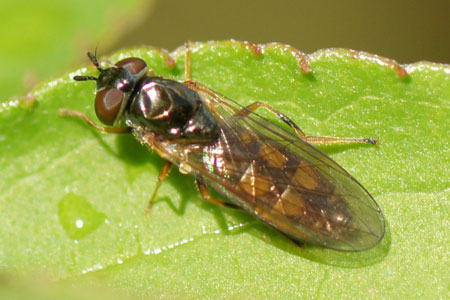 .. ..
 . .
 Variable Duskyface (Melanostoma mellinum). Genus: Melanostoma. Family hoverflies (Syrphidae).
Variable Duskyface (Melanostoma mellinum). Genus: Melanostoma. Family hoverflies (Syrphidae).
Another difference is that the face is shiny, while a part of the face of a
m. scalare is covered in a greyish powder. Only along the eye you see a little
grey. The arista is almost bald.
The melanostoma mellinum is in our garden much less common than the m. scalare.
This hoverfly I saw the end of November. It was very bad weather. Perhaps therefore the thorax
is damaged. (dented)
Length 5 - 8 mm.
April - November.
Photo 30-9-2012, 3-10-2013. |
Xanthandrus.
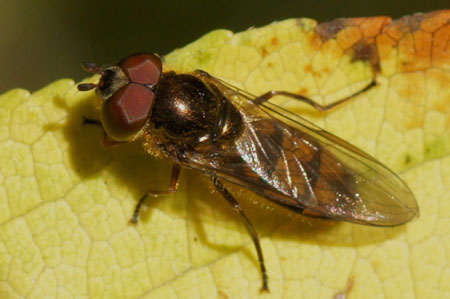 .. ..
 . .
 . .
 Migrant Flatbelly (Xanthandrus comtus). Genus: Xanthandrus. Family hoverflies
(Syrphidae).
Migrant Flatbelly (Xanthandrus comtus). Genus: Xanthandrus. Family hoverflies
(Syrphidae).
It's a dark hoverfly. It has a flat abdomen with
orange spots. In the male, the spots on abdominal segment 3 and 4 are connected. In the female they are separated and the spots on
abdominal segment 2 are missing . They can be found in woodland edge.
The larvae appear to feed on on gregarious caterpillars of yponomeutid and tortricid
micro-moths. Length: 10 - 12 mm.
May - November.
|
Melangyna, Meligramma and Meliscaeva.
Melangyna hoverflies with a slim body.
They are quite small. They look like the hoverflies of the genus
Meligramma and Meliscaeva. The larvae of both genera feed on aphids.
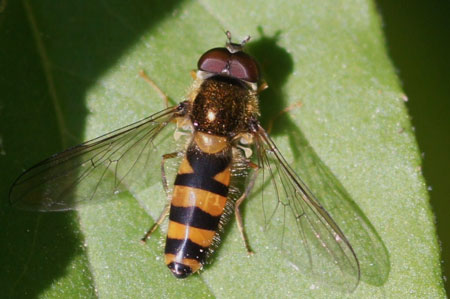 .. ..
 . .
 . .
 Ringed Beech Fly (Fagisyrphus cinctus syn. Melangyna cincta). Genus Melangyna. Family hoverflies (Syrphidae).
Ringed Beech Fly (Fagisyrphus cinctus syn. Melangyna cincta). Genus Melangyna. Family hoverflies (Syrphidae).
Features: On the second segment of the abdomen, the triangular
spots have the point to the inside. It has a yellow shield with yellow hairs and yellow antennae.
Length: 8 - 10 mm.
March - September. |
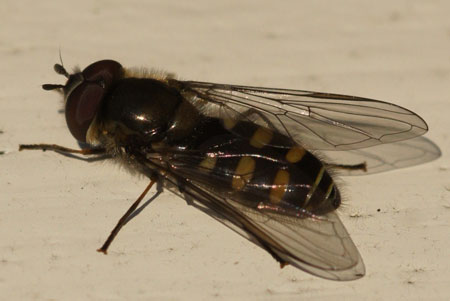 .. ..
 . .
 Spring Halfband (Melangyna lasiophthalma). Genus Melangyna. Family hoverflies (Syrphidae).
Spring Halfband (Melangyna lasiophthalma). Genus Melangyna. Family hoverflies (Syrphidae).
Features: On the abdomen are small white-yellow to orange spots. A dark shiny thorax.
This hoverfly visits the flowers of early flowering shrubs such as willow and blackthorn.
Length 8-10 mm.
March-June.
Large parts of Europe, North America.
Photo 20-03-2011. The first new (for me) hoverfly, which I saw in the garden this year.
Sitting in the sun on the sill of the window
Last Photo: 15-03-2012. |
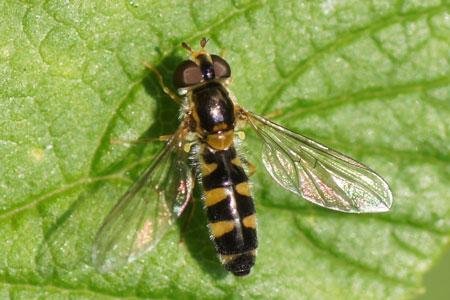 .. ..
 Triangle-spotted Roundtail (Meligramma triangulifera).
Genus Meligramma. Family hoverflies (Syrphidae).
Triangle-spotted Roundtail (Meligramma triangulifera).
Genus Meligramma. Family hoverflies (Syrphidae).
The spots on the abdomen are triangular. It can be confused with the Meliscaeva
auricollis, but the spots of the Meligramma triangulifera reach the outside edge of the
abdomen. On thhe yellow scutellum are yellow hairs. The tarsi of the
frontlegs are yellow. The thorax is very shiny.
Length 8-10 mm.
March-September. Probably two generations. The larvae overwinter.
Photos 14-7-2013. |
Sphaerophoria.
The male and female are different. The male has a more slender body, which looks
like a stick. Most species are difficult or impossible to determine from a photo.
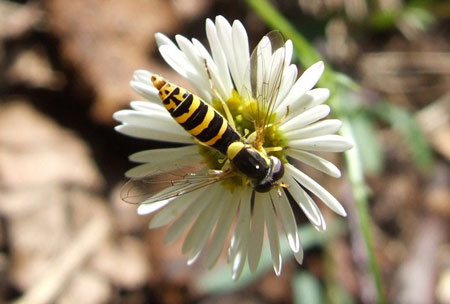 Female
Female
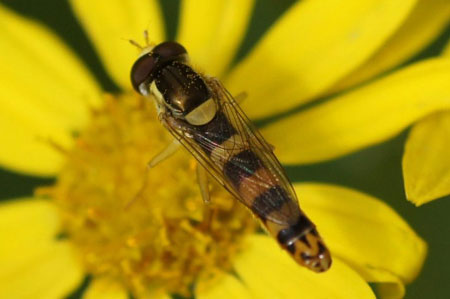 Male.
Male. |
 Female.
Female.
 . .
 . .
 Male. Common Globetail (Sphaerophoria
scripta). Genus:
Sphaerophoria. Family hoverflies (Syrphidae). (The
female perhaps
another species)
Male. Common Globetail (Sphaerophoria
scripta). Genus:
Sphaerophoria. Family hoverflies (Syrphidae). (The
female perhaps
another species)
Unlike other species, the body of the male is longer than the wings. The bands are yellow or yellow-orange. The
scutellum is yellow. Females are not to identify. You are only sure, when
a female and a male are together.
Male 10 mm long, female 8 mm.
April-October.
The
larvae feed on aphids. German: Gemeine Stiftschwebfliege French:
Sphaerophore notée.
|
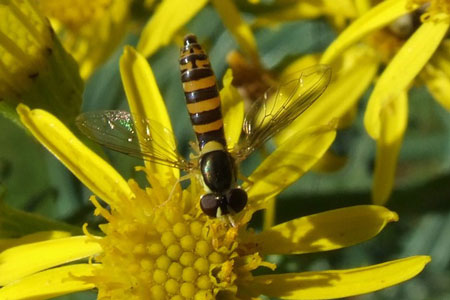 Female.
Female. 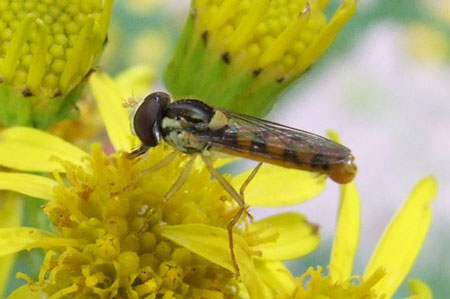 Male.
Male. |
Brachypalpoides,
Chalcosyrphus, Xylota.
 .. ..
 . .
 Crimson-belted Leafwalker (Brachypalpoides lentus). Genus:
Brachypalpoides. Family hoverflies (Syrphidae).
Crimson-belted Leafwalker (Brachypalpoides lentus). Genus:
Brachypalpoides. Family hoverflies (Syrphidae).
A
large fly. A conspicuous red spot on the back and black legs.
Length 11-14 mm.
April-July.
Deciduous forests and sandy.
Larvae in rotting wood.
Photos 5-6-2012. |
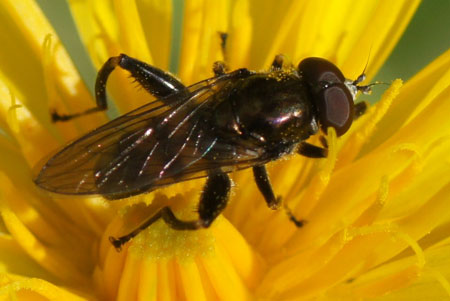 .. ..
 . .
 Small Leafwalker (Chalcosyrphus nemorum). Genus Chalcosyrphus. Family hoverflies (Syrphidae).
Not in the garden but in the dunes about 3 km from my house.
Small Leafwalker (Chalcosyrphus nemorum). Genus Chalcosyrphus. Family hoverflies (Syrphidae).
Not in the garden but in the dunes about 3 km from my house.
A black hoverfly with a rather short abdomen. On the abdomen
four yellow to orange rectangular spots.
Length 7-10 mm.
April-September. Two generations.
Often in deciduous forests near water. The hoverfly also visits flowers. Larvae
live under the bark of dead wood that is in a damp place. Photos 12-7-2012. |
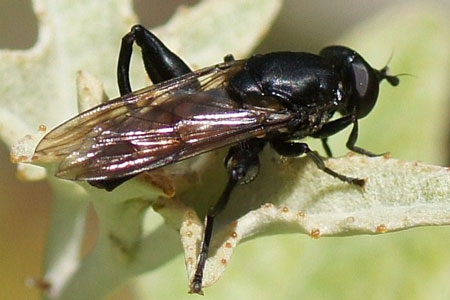 .. ..
 . .
 Red-tailed Leafwalker (Chalcosyrphus piger). Genus
Chalcosyrphus.
Not in the garden but in the dunes about 3 km from my house.
Rare, but this hoverfly is frequently found in the dunes near Bergen.
Red-tailed Leafwalker (Chalcosyrphus piger). Genus
Chalcosyrphus.
Not in the garden but in the dunes about 3 km from my house.
Rare, but this hoverfly is frequently found in the dunes near Bergen.
The abdomen is red. Unfortunately this isn't visible in this
photo. The legs are black, thorax and scutellum are dull black. The thighs of the hind legs are quite thick.
The lives in damp pine forests with rich undergrowth. You see them both on leaves and flowers. The larvae live in rotten spots behind the bark of pine and spruce.
Length: 11-13 mm.
April-September. Holearctic.
Photos 26-7-2012, 23-8-2012. On the last photos left is the red abdomen
much better visible.
|
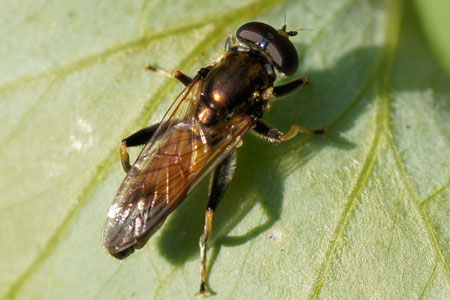 .. ..
 . .
 . .
 Orange-belted Leafwalker (Xylota segnis). Genus: Xylota. Family hoverflies (Syrphidae).
Orange-belted Leafwalker (Xylota segnis). Genus: Xylota. Family hoverflies (Syrphidae).
A hoverfly which slightly resembles an
Ichneumon wasp. Orange and black.
It has a preference for feeding on honey-dew secreted by aphids. That's why
it is often been seen on leaves. It visits less often flowers.
In hedgerows and woodland.
Length: 9-14 mm.
April-October. Larvae are found in rotting sawdust, rotting wood
etc. |
 .. ..
 . .
 . .
 Golden-tailed Leafwalker (Xylota sylvarum).
Genus Xylota. Family hoverflies (Syrphidae).
Golden-tailed Leafwalker (Xylota sylvarum).
Genus Xylota. Family hoverflies (Syrphidae).
A large fly. The end of the black abdomen has golden
hairs. The yellow shins have a black ring. This is different from the
similar X. xanthocnema. Which has yellow shins.
This xylota stayed one hour at about the same spot flying and jumping from leaf to leaf to. They do that
often I have read.
Length 11-16 mm.
May-September.
Larvae in rotting wood. Palearctic.
Photos 10-7-2012, 3-7-2011. |
Syritta.
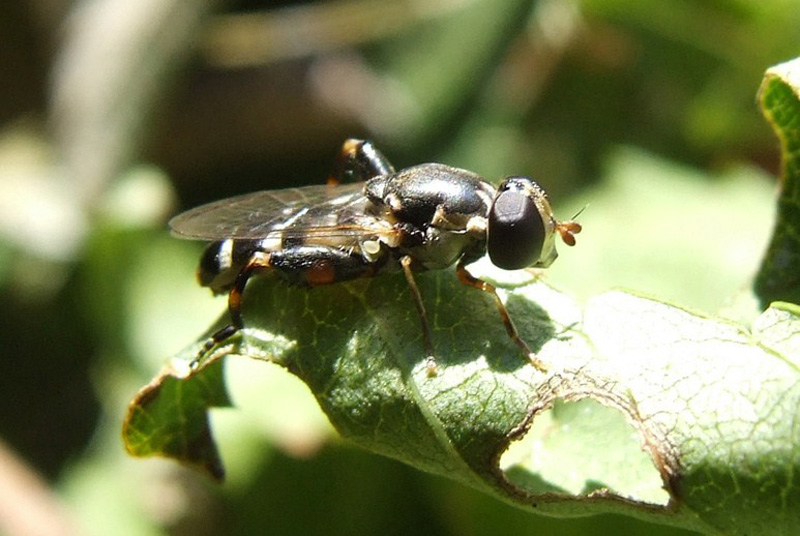 .. ..
 . .
 . .
 Thick-legged hoverfly, Common Compost Fly (Syritta
pipiens). Genus:
Syritta.
Family hoverflies (Syrphidae).
Thick-legged hoverfly, Common Compost Fly (Syritta
pipiens). Genus:
Syritta.
Family hoverflies (Syrphidae).
A small, slim hoverfly. During the
float it can propel jerky.
The Thick-legged hoverfly is easily to recognize by the swollen hind femora.
On the hind femur (the ventral edge) it has a row of spines. At the side
of the thorax it has a white spot.
The Netherlands has only one species. So you can not be mistaken. In Europe there are three
species.
The larva lives of waste on the soil or compost. Length: 7-9 mm.
April-October. Two generations (probably)
Native to Eurasia and the Orient. Introduced in North America and Mexico. |
Tropidia.
 .. ..
 . .
 . .
 Swamp Thickleg (Tropidia scita). Genus: Tropidia. Family hoverflies (Syrphidae).
Swamp Thickleg (Tropidia scita). Genus: Tropidia. Family hoverflies (Syrphidae).
A dark back with silver spots on the corners. Large orange spots on the abdomen.
Black, swollen hind femora arched with a triangular projection. (Visible on
the photo below)
This is the only species in the Netherlands.
Moist to wet habitats. They fly low and also visit flowers. As you can see
on these pictures.
The larvae live in decaying plant debris on the edges of fens, pounds,
etc. But they don't know much about it.
Length: 7-11 mm.
April-September. Photos 4-6-2010, 15-5-2011.
 Black, swollen hind femora arched with a triangular projection. Photo
14-5-2013.
Black, swollen hind femora arched with a triangular projection. Photo
14-5-2013.
|
Neoascia.
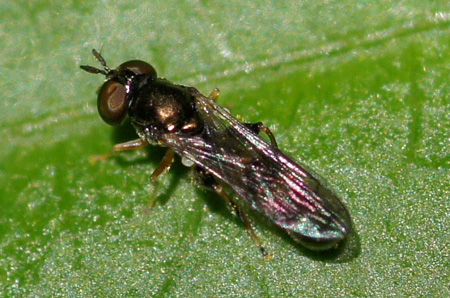 .. ..
 Smudge-veined Fen Fly (Neoascia podagrica). Genus: Neoascia. Family hoverflies (Syrphidae).
Smudge-veined Fen Fly (Neoascia podagrica). Genus: Neoascia. Family hoverflies (Syrphidae).
There are similar species. But they are very
rare in the Netherlands.
A small hoverfly. The abdomen of this species is
waisted. (Especially the females) and club shaped.
The Neoascia has like the Syritta thick backthigh. The Neoascia podagrica
has
dark cross veins.
Length: 5-6 mm.
April-October.
Photos 17-6-2011. |
Baccha.
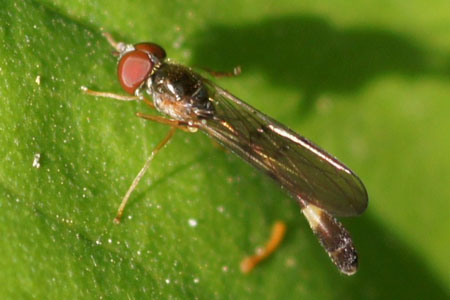 .. ..
 . .
 Common Dainty (Baccha elongata). Genus: Baccha. Family hoverflies (Syrphidae).
Common Dainty (Baccha elongata). Genus: Baccha. Family hoverflies (Syrphidae).
In the bushes flew this little thin hoverfly. There
you'll find it often. They can be found in shady, damp places.
It has a slender body like an ichneumon wasp. It is difficult to see, because it is so thin.
Length: 7-11 mm.
April-November.
The larvae feed on aphids.
Photos 25-9-2008, 26-4-2011.
German: Gemeine Schattenschwebfliege.
|
To hoverflies
1
I want to thank everyone, who has helped me (waarneming.nl)
to identify. In particular
Gerard Pennards, Han Endt and Menno Reemer.
Nederlands /
Dutch
 
Subpage flies:
Tachinidae
Blow-flies
(Calliphoridae) House
flies (Muscidae) Soldierflies
(Stratiomyidae) Root-Maggot
Flies (Anthomyiidae) Small
flies Gnats
Subpage wasps, bees, bumblebees: Parasitica, Ichneumonidae
Sawflies
symphyta Bumblebees
Bee hotel
Subpage France: Insects
France
|
